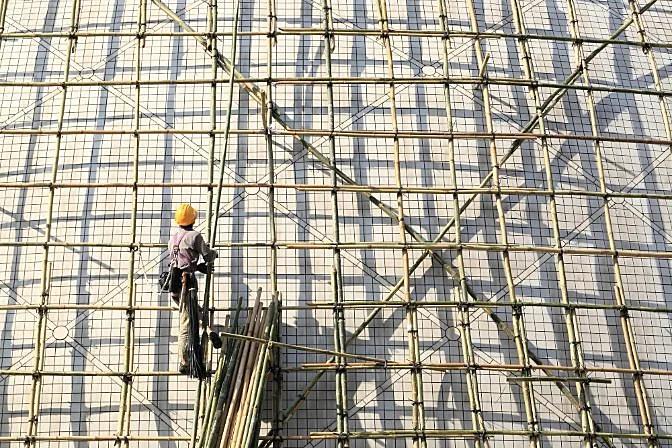Exploring the Different Sorts Of Scaffolding Made Use Of in Building And Construction Projects
The construction industry relies heavily on different types of scaffolding to satisfy details task needs, each offering distinct advantages and applications. Conventional framework scaffolding offers a strong structure for basic jobs, while suspended scaffolding is necessary for job on skyscraper frameworks.

Traditional Structure Scaffolding
Conventional framework scaffolding is just one of one of the most commonly utilized approaches in the building sector because of its robustness and convenience. This system contains upright and horizontal structures that are put together to develop a steady system for materials and employees. The main elements consist of vertical blog posts, horizontal journals, and diagonal braces, which with each other supply a strong structure that can support substantial loads.
Among the key advantages of standard structure scaffolding is its adaptability to various building tasks, varying from household buildings to large commercial structures. The modular style enables for simple setting up and disassembly, making it effective for both lasting and temporary tasks. In addition, the system can be tailored in elevation and size, fitting various building styles and site problems.
Safety and security is extremely important in scaffolding applications, and standard frame systems are furnished with guardrails and toe boards to protect against falls and make certain worker security. Furthermore, regular evaluations and adherence to safety and security guidelines are critical in preserving the integrity of the scaffold. In general, standard structure scaffolding stays a fundamental option in the building market, providing a dependable platform for labor and improving general job performance

Suspended Scaffolding
Suspended scaffolding provides a special option for building and construction tasks that call for access to raised surface areas, specifically in situations where traditional frame scaffolding might be unwise. This kind of scaffolding is usually put on hold from the roof or top degrees of a structure, using a system of sheaves, ropes, and systems to create a working area that can be gotten used to numerous elevations.
One of the primary advantages of put on hold scaffolding is its adaptability. It can be conveniently rearranged or reduced to fit modifications in construction requirements, making it ideal for jobs such as window installation, frontage work, and upkeep on high-rise structures. Additionally, the marginal impact of suspended scaffolding enables better use ground area in urban environments, where space is frequently restricted.
Security is a crucial consideration in the usage of suspended scaffolding. Overall, put on hold scaffolding offers a effective and reliable option for accessing hard-to-reach areas in different building circumstances, improving both productivity and security on site.
System Scaffolding
System scaffolding, usually related to as a modern remedy in the scaffolding industry, is composed of pre-engineered components that can be swiftly put together and adjusted for various building and construction projects. Scaffolding. This kind of scaffolding is characterized by its modular style, which enables flexibility and performance on task websites, accommodating structural demands and various heights
Normally made from high-strength steel or light weight aluminum, system scaffolding provides improved resilience and security. The components consist of vertical articles, straight ledgers, and diagonal dental braces, which adjoin securely, guaranteeing a durable structure. The design commonly includes standardized fittings, simplifying assembly and disassembly processes, consequently reducing labor time and costs.

Rolling Scaffolding
Rolling scaffolding is a versatile choice to conventional set scaffolding, created for movement and convenience of use on construction websites. This type of scaffolding is composed of a platform sustained by frames with wheels, permitting workers to conveniently move it as required. The movement attribute substantially enhances performance, as it decreases downtime connected with assembling and dismantling taken care of scaffolding.
Typically created from light-weight products such as aluminum or steel, rolling scaffolding uses a sturdy yet portable remedy for projects needing constant repositioning - Scaffolding. It is particularly beneficial in jobs such as paint, drywall installation, and electrical job, where accessibility to various heights and areas is necessary
Security is vital in rolling scaffolding layout, with attributes such as securing wheels to prevent unexpected activity when in usage, and guardrails to safeguard workers from falls. In addition, several models are adjustable in height, fitting different job demands.
Cantilever Scaffolding

The layout of cantilever scaffold examples scaffolding typically includes utilizing braces or arms secured to a building or framework, enabling the platform to expand external safely. Security is paramount; therefore, these scaffolds must be crafted to withstand numerous loads and environmental problems. Normal inspection and upkeep are essential to make sure structural stability and employee safety and security.
Cantilever scaffolding is favored for its convenience and efficient use room, making it a popular option in city environments where area restraints prevail. Furthermore, it promotes easier access to high altitudes, inevitably adding to the general performance of building and construction projects. As with all scaffolding types, proper training and adherence to safety standards are important for employees making use of cantilever scaffolding.
Conclusion
Standard framework scaffolding provides security, while suspended scaffolding offers versatility for raised tasks. System scaffolding facilitates fast assembly, and original site rolling scaffolding boosts wheelchair for varying job atmospheres.
Conventional frame scaffolding supplies a durable structure for general jobs, while suspended scaffolding is essential for job on high-rise frameworks.Moving scaffolding is a flexible option to typical fixed scaffolding, designed for wheelchair and convenience of use on building and construction websites. As with all scaffolding kinds, proper training and adherence to security standards are vital for employees using cantilever scaffolding.
Conventional frame scaffolding gives security, while put on hold scaffolding uses convenience for raised tasks. System scaffolding helps with quick setting up, and rolling scaffolding improves flexibility for differing job atmospheres.